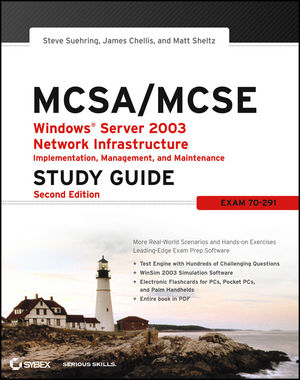MCSA / MCSE: Windows Server 2003 Network Infrastructure Implementation, Management, and Maintenance Study Guide: Exam 70-291, 2nd EditionISBN: 978-0-7821-4449-9
Paperback
600 pages
February 2006
 This is a Print-on-Demand title. It will be printed specifically to fill your order. Please allow an additional 10-15 days delivery time. The book is not returnable.
|
||||||
Assessment Test.
Chapter 1: Understanding Windows Server 2003 Networking.
The OSI Model.
Protocol Stacks.
Communication between Stacks.
Microsoft’s Network Components and the OSI Model.
Device Drivers and the OSI Model.
The Basics of Network Protocols.
Understanding IP Addressing.
The Hierarchical IP Addressing Scheme.
Subnetting a Network.
Implementing Subnetting.
Applying Subnetting.
Quickly Identifying Subnet Characteristics.
Summary.
Exam Essentials.
Review Questions.
Answers to Review Questions.
Chapter 2: Installing and Configuring TCP/IP.
Configuring Basic TCP/IP Settings.
The Default Gateway and DNS Settings.
Configuring Automatic TCP/IP Settings.
Configuring Manual TCP/IP Settings.
Configuring Advanced TCP/IP Settings.
Expanding the Basic Settings.
Configuring Advanced DNS Settings.
Configuring WINS Clients.
Configuring Network Bindings.
Monitoring Network Traffic.
Installing the Network Monitor Driver and Application.
How to Use Network Monitor.
Monitoring Network Activity with System Monitor.
Troubleshooting Network Protocols.
Analyzing Recent Changes.
Pinpointing the Cause of the Problem.
Checking Physical Connections.
Using Ipconfig.
Using Ping, Tracert, and Pathping.
Using Nslookup.
Summary.
Exam Essentials.
Review Questions.
Answers to Review Questions.
Chapter 3: Administering Security Policy.
An Overview of User and Group Accounts.
User Accounts.
Group Accounts.
Security Policy Types and Tools.
Group Policies within Active Directory.
Administering Local Computer Policy.
Configuring Security Settings.
Administering the Local Computer’s System Policies.
User Profiles Policies.
Logon Policies.
Disk Quota Policies.
Group Policy Policies.
Windows File Protection Policies.
Analyzing Security Configurations with the Security Configuration and Analysis Tool.
Specifying a Security Database.
Importing a Security Template.
Performing a Security Analysis.
Reviewing the Security Analysis and Resolving Discrepancies.
Managing Software Installation and Maintenance.
Windows Update.
Windows Automatic Updates.
Using Windows Server Update Services.
Using the Microsoft Baseline Security Analyzer.
Managing Windows Server 2003 Services.
Configuring General Service Properties.
Configuring Service Log On Properties.
Configuring Service Recovery Properties.
Checking Service Dependencies.
Summary.
Exam Essentials.
Review Questions.
Answers to Review Questions.
Chapter 4: Managing IP Security.
Understanding How IPSec Works.
IPSec Fundamentals.
IPSec Authentication.
Installing IPSec.
The IP Security Policy Management Snap-In.
Configuring IPSec.
Creating a New Policy.
Assigning and Unassigning Policies.
Other Policy Management Features.
Configuring IPSec Policies.
Configuring IPSec for Tunnel Mode.
Managing and Monitoring IPSec.
Using IP Security Monitor.
Using Netsh for IPSec Management.
Using Event Logging.
Monitoring IPSec Activity in Network Monitor.
Troubleshooting IPSec.
Identifying Common IPSec Issues.
Verifying That the Right Policy Is Assigned.
Checking for Policy Mismatches.
Summary.
Exam Essentials.
Hands-On Lab: Using Event Viewer to Troubleshoot IPSec Connections.
Review Questions.
Answers to Review Questions.
Chapter 5: Managing the Dynamic Host Configuration Protocol (DHCP).
Overview of DHCP.
Advantages and Disadvantages of DHCP.
The DHCP Lease Process.
Understanding Scope Details.
Installing DHCP.
Authorizing DHCP for Active Directory.
Creating and Managing DHCP Scopes.
Creating a New Scope.
Changing Scope Properties.
Changing Server Properties.
Managing Reservations and Exclusions.
Setting Scope Options.
Activating and Deactivating Scopes.
Creating a Superscope.
Creating Multicast Scopes.
Integrating Dynamic DNS and DHCP.
Using Multiple DHCP Servers.
Monitoring and Troubleshooting DHCP.
Monitoring DHCP Leases.
Logging DHCP Activity.
Working with the DHCP Database Files.
Reconciling DHCP Scopes.
Solving the Problem of Multiple DHCP Servers and Scopes.
Correcting Client Problems.
Summary.
Exam Essentials.
Review Questions.
Answers to Review Questions.
Chapter 6: Installing and Managing Domain Name System (DNS).
DNS Fundamentals.
What DNS Does.
Servers, Clients, and Resolvers.
The DNS Zone File.
DNS and Windows Server 2003.
Installing and Configuring a DNS Server.
Installing a DNS Server.
Configuring a DNS Server.
Creating New Zones.
Setting Zone Properties.
Configuring Zones for Dynamic Updates.
Delegating Zones for DNS.
Manually Creating DNS Records.
Monitoring and Troubleshooting DNS.
Monitoring DNS with the DNS Snap-In.
Monitoring DNS Servers with System Monitor.
Monitoring DNS Events in the Event Viewer.
Monitoring DNS in Replication Monitor.
Troubleshooting DNS.
Summary.
Exam Essentials.
Review Questions.
Answers to Review Questions.
Chapter 7: Managing Remote Access Services.
Overview of Dial-Up Networking (DUN).
What DUN Does.
How DUN Works.
Overview of Virtual Private Networks.
What VPNs Do.
VPNs and Windows Server 2003.
How VPNs Work.
Installing the Routing and Remote Access Services.
Configuring Your Remote Access Server.
Setting General Configuration Options.
Configuring Inbound Connections.
Installing a VPN.
Setting Up Your Server.
Installing RRAS as a VPN Server.
Configuring a VPN.
Configuring VPN Ports.
Troubleshooting VPNs.
Managing Your Remote Access Server.
Monitoring Overall Activity.
Controlling Remote Access Logging.
Reviewing the Remote Access Event Log.
Monitoring Ports and Port Activity.
Integrating RRAS with DHCP.
Installing the DHCP Relay Agent.
Configuring the DHCP Relay Agent.
Configuring a RAS or VPN Client.
The General Tab.
The Options Tab.
The Security Tab.
The Networking Tab.
The Sharing Tab.
Summary.
Exam Essentials.
Review Questions.
Answers to Review Questions.
Chapter 8: Managing User Access to Remote Access Services.
Remote Access Security.
User Authentication.
Connection Security.
Access Control.
Configuring User Access.
Using User Profiles.
Using Remote Access Policies.
Using Remote Access Profiles.
Setting Up a VPN Remote Access Policy.
Configuring Security.
Controlling Server Security.
Controlling Security at the Policy Level.
Configuring RADIUS.
Troubleshooting Example.
Summary.
Exam Essentials.
Review Questions.
Answers to Review Questions.
Chapter 9: Managing IP Routing.
Understanding IP Routing.
What Routing Does.
How Routing Works.
Routing and Windows Server 2003.
Installing RRAS.
Configuring IP Routing.
Creating and Managing Interfaces.
Setting IP Routing Properties.
Managing Routing Protocols.
Managing Static Routes.
Configuring TCP/IP Packet Filters.
Configuring VPN Packet Filters.
PPTP Packet Filters.
L2TP Packet Filters.
Managing IP Routing.
Using the route print Command.
Troubleshooting IP Routing.
Troubleshooting Example.
Summary.
Exam Essentials.
Review Questions.
Answers to Review Questions.
Glossary.
Index.



